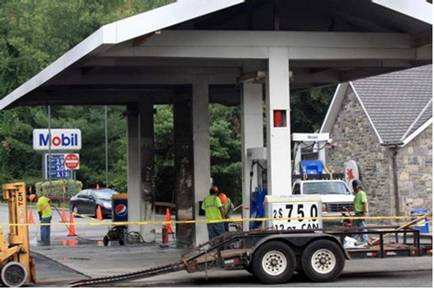
Incident Report Subject: USA - NY Firefighters Concern over Potential Change to Gas/Fuel Retail Station Safety Regulation Date of Email report: Tue 17/09/2013 Report Detail:
New York’s largest fire-fighters association raised concerns Monday over a proposal to no longer require fire-suppression systems at gas stations. At a news conference near the Capitol, the Fire-fighters Association of the State of New York joined Assemblyman Anthony Brindisi, D-Utica, to urge the New York State Code Council to keep the mandate. “This regulation has been on the books in New York for decades and has protected many New Yorkers from serious harm,” Brindisi said. “We need to ensure that this vital safety measure continues to be the law.” The council is in the process of updating New York’s Uniform Fire Prevention and Building Code. In January, a subcommittee recommended removing the requirement. As it stands, gas stations are required to have a canopy over their pumps with fire-suppressing chemicals in case of a fire. At the news conference, the fire-fighter group showed video of the system in action during a Harrison explosion in August 2010 that totaled four cars and left six people with minor injuries. The surveillance footage showed a red hatchback backing into a pump, leading to an instant burst of flames followed by a continuous stream of white, cloud-like powder — the dry chemical suppressant — falling from overhead. It’s not clear if or when the full Code Council plans on taking up the proposal. Its next meeting is Dec. 11. James Burns of Verplanck, the president of the Fire-fighters Association, said the proposed change is concerning given the state’s recent move to require generators at more gas stations in the wake of Superstorm Sandy. While he said that’s the right move, power generators can be a fire risk. “That makes it imperative that we continue to mandate fire-suppression systems in New York state,” he said. At the January meeting, some members raised concerns about accidental discharges from the fire-suppression system and the potential hazards it could cause. Laz Benitez, a spokesman for the state Department of State, said the subcommittee’s recommendation is “just that — a recommendation.” The State Department oversees the Code Council. “Under no circumstances will the public's safety be put at risk by these efforts to modernize New York's fire code,” Benitez said in a statement. Additional Documentation: Brindisi: Gas stations need fire suppression canopies (update) Assemblyman Anthony Brindisi, D-Utica, joined fire safety experts to warn against a potential change to the three-decade-old requirement that New York State’s gas stations must maintain fire-suppression canopies over pumps. “We need to ensure that this vital safety measure continues to be the law in New York,” he told reporters Monday. Brindisi chairs the chamber’s Volunteer Emergency Services subcommittee. In January, the Department of State’s Fire Code Technical Subcommittee voted 5-2 to drop the mandate from state code. The proposal is now being considered by the 17-member Code Council, which is in the process of updating New York’s Uniform Fire Prevention and Building Code. Industry groups that represent fuel retailers say that modern technology, including automatic shutoffs that cut the flow of fuel in the event of fire, has reduced the need for suppression systems at the retail level, and cite cost and incidents of accidental activation as supporting arguments for ending the requirement. A June letter from James Calvin, president of the state Association of Convenience Stores, to the Division of Code Enforcement and Administration said the systems at retail stations “pose as much danger and chaos as they provide protection, and we believe the costs now outweigh the benefits.” Calvin’s letter says that his organization’s members “advise me that fire suppression systems are very costly to install, maintain, and recharge. Moreover, they are prone to accidental discharge, which damages cars and clothing, disrupts fueling operations, sparks customer fear and outrage, and ruins business reputations.” He cited a June incident in Newport, Vt., where a woman was struck and killed by a driver trying to pull away from gas pumps after the fire suppression system had discharged. In an interview, Calvin said he could not say how often suppression systems accidentally discharged. “If you’re looking for empirical evidence, I don’t have it,” he said. The committee unanimously agreed that currently installed systems should be required to be maintained, and can only be removed if the entire fuel-dispensing system meets the requirements of the Fire Code of New York State for new construction — including shutoff valves. Dan Nichols, the Fire Code Technical Subcommittee’s chair, referred comment to the Department of State’s press office. Update: “The fire code technical subcommittee’s recommendation is just that – a recommendation,” said DOS spokesman Laz Benitez. “The Department of State is in its early stages of reviewing this policy, but under no circumstances will the public’s safety be put at risk by these efforts to modernize New York’s fire code.”
|

